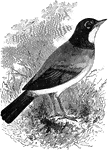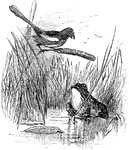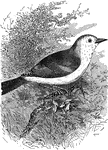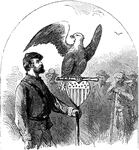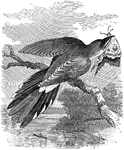
Brush Turkey
"Catheturus lathami, the "Brush Turkey" of Eastern Australia, is blackish-brown with greyish under surface,…

Crested Curassow
Crax alector, Crested Curassow, is black with a purplish gloss, the belly being white, the naked lores…

Pheasant
"Phasianus colchicus, Pheasant, ...has a white collar and slaty lower back with dark green barring;…

Cabot'sTragopan
"Ceriornis caboti, (Cabot's Tragopan) of South-East China has the latter region buff. The hens are black…
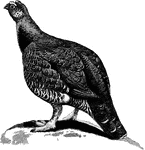
Red Grouse
"Lagopus scoticus, the Red Grouse or Muirfowl, the only bird entirely confined to our islands, differs…

Hoatzin
"The Hoatzin (Opisthocomus cristatus) is curious and highly specialized. "The body is long and thin,…
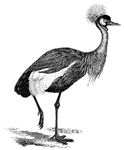
Crowned Crane
"Balearica pavonina, the "Crowned" Crane of the Northern Ethiopian Region, is greenish-black above and…

Trumpeter
"Psophia crepitans, the Agami, ranging from British Guiana to Amazonia, is a black bird with velvety…
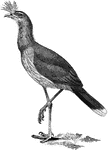
Seriemá
"Cariama cristata, the Seriemá, or Crested Screamer, extending from Pernambuco to Paraguay and…
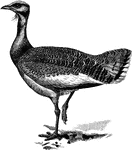
Great Bustard
"The Otis Tarda, the Great Bustard, which, as a native only became extinct in Norfolk about 1838, used…
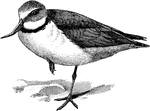
Wry-bill
Anarhynchus frontalis, the Wry-bill of New Zealand, is grey, with a black gorget and whitish lower parts;…

Curlew
"Numenius arquata, the Curlew or Whaup, breeds freely on the moorlands of Britain; and extends throughout…

Woodcock
"Scolopas rusticula, the well known Woodcock, brown, grey, and buff in color, with blackish vermiculations…
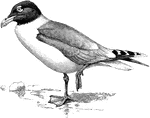
Great Black-Headed Gull
"Larus ichthyaetus, the Great Black-headed Gull, ranging from the Black Sea and the Levant to Tibet,…
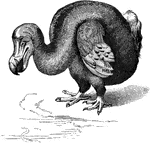
Dodo
"The Dodo, ...was an immense Pigeon-like bird bigger than a Turkey, with an aborted keel to the sternum…
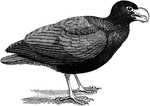
Tooth-Billed Pigeon
Didunculus strigirostris, the Manu-mea or Red Bird of the islands of Upolu, Salvai, and Tutuila in Samoan…
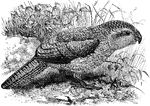
Kakapo
"Stringops habroptilus, the Kakapo or Tarapo of New Zealand has sap-green upper parts, with yellow middles…
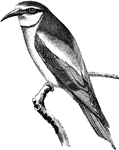
Bee Eater
"Merops Apiaster, the Bee-eater, has ruddy-brown head, neck, upper back, and broad alar bar, buff lower…
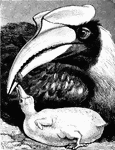
Female Hornbill Laying Down Feeding Her Young
"Dichoceros bicornis of India and the Malay countries has a large yellowish-red casque, hallowed and…

Hoopoe
"Upupa epops, not unfrequently visits Britain, where it has nested on several occasions; it breeds from…
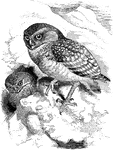
Two Burrowing Owls by the Mountains
"Speotyto cunicularia, the Burrowing Owl, a comparatively long-legged and short -winged bird with incomplete…

Common Swift Flying Through the Air by a Structure and a Tree with its Mouth Open
"The coloration of the twenty or more species of Cypselus is sooty-black or mouse-brown, frequently…
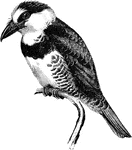
Puff-bird
"Bucco hyperrhynchus, or Puff-bird, is blue-black, with a white under surface crossed by a broad black…
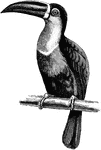
Ariel Toucan
The Rhamphastus ariel, or Ariel Toucan, is black with a yellow or orange rump and throat. The brilliant…

A Wryneck Sitting on a Tree
"Iynx torquilla, the Cuckoo's-mate or Snake-bird, is fairly common in England, and extends thence to…

A Broadbill Sitting on a Tree Branch
"The plumage in the Calyptomena viridis of the Indo-Malay countries is bright green, with large black…
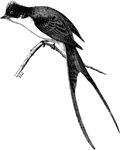
Scissor-tail
"Milvulus tyrannus, Scissor-tail, normally exhibits olive, grey, yellow, or white in varying proportions."…
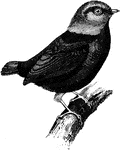
Red-capped Manakin
Pipra mentalis, the Red-capped Manakin, has black plumage with a red head, neck, and thighs.
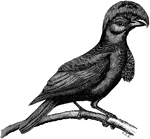
Amazonian Umbrella Bird
"Cephalopterus ornatus, the Umbrella bird, is entirely black, with a huge expanded umbrella-like crest…

Bell-Bird
"Chasmorhynchus niveus, the Bell-bird, ...have lores and orbits bare. The plumage is ordinarily plain…

The Nest of an Oven-bird
"The curious nest is placed in exposed situations on branches, in forks of trees or shrubs, on posts,…

Lyre-bird
"Menura superba, the Lyre-bird, of New South Wales and South Queensland, some thirty-three inches long,…
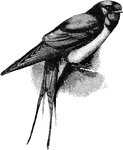
Swallow
"Hirundo rustica, the Swallow, is metallic black, with a variable amount of chestnut or rufous on the…

Advantage Rebus
"A bird in the hand is worth two in the bush." Its better to have a small advantage rather than a greater…
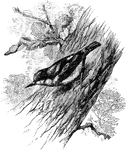
Nuthatch
"The colours in Sitta caesia, (Nuthatch) which ranges over nearly all the Palaearctic and Indian Regions,…

D'Albertis' Bird of Paradise
"Drepanornis albertisi, D'Albertis' Bird of Paradise, is rufous-brown, with green throat and ante-ocular…
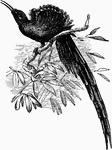
Long-tailed Bird of Paradise
"Falcinellus speciosus, Long-tailed Bird of Paradise, is black with rainbow-like reflections; the broad…
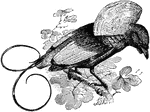
Magnificent Bird of Paradise
"Diphyllodes magnifica, Magnificent Bird of Paradise, has a brown head and under surface, green throat…
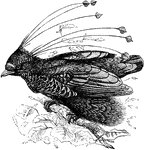
Six-wired Bird of Paradise
"Parotia sexpennis, the Six-wired Bird of Paradise, is bronzy- and purplish-black, having scale-like…
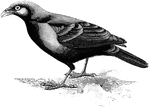
Satin Bower-bird
"Ptilorhynchus violaceus, the Satin Bower-bird, is purplish-black, with much feathered culmen. Female…

A Magpie Sitting on a Tree Branch Looking Down While Surrounded by Other Trees
"The Pica rustica, or Magpie, extends through the Palaearctic Region, and reaches Formosa and North…

Tui
"Prosthemadera novae zealandiae, the Tui, are black and white... two gular patches of curled white filamentary…
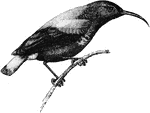
Splendid Sun-bird
"Cinnyris splendidus, the Old World Sun-birds, recalling the non-Passerine Humming-birds by their brilliant…

Sugarbird
"Certhiola flaveola, the Sugar-bird, coloration varies from black, grey, or purplish, relieved by rufous…

Weaver-bird
"Pyromelaena flammiceps, the Weaver-birds, the coloration of these rather small birds is most striking,…
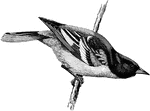
Baltimore Oriole
icterus baltimore, Baltimore Oriole, are glossy black, with yellow, bay, or orange patches-especially…

The Skeleton of the Trunk of a Falcon
"Skeleton of the trunk of a Falcon. Ca, coracoid, which articulates with the sternum (St) at ; Cr, keel…

Skeleton of the Limbs and Tail of a Carinate Bird
"Skeleton of the Limbs and Tail of a Carinate Bird. (The skeleton of the body is indicated by dotted…

Diagram of the Pelvis of a Kiwi
"Pelvis of Apteryx austrlis. Lateral view. a, Acetabulum; il, ilium; is, ischium; p, pectineal process…

Diagram of the Skull of a Wild Duck
"Skull of a Wild Duck (Anus boscas), from the side. ag, Angular; als, alisphenoid; ar, articular; bt,…
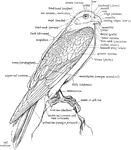
A Labeled Diagram of a Falcon to Show the Nomenclature of the External Parts
"The annexed figure explains the nomenclature of most of the outward of a Bird, but some further explanations…

Archaeopteryx Lithographica
"Archaeornithes is at present represented by but one member, the first undoubted fossil Bird, made known…

